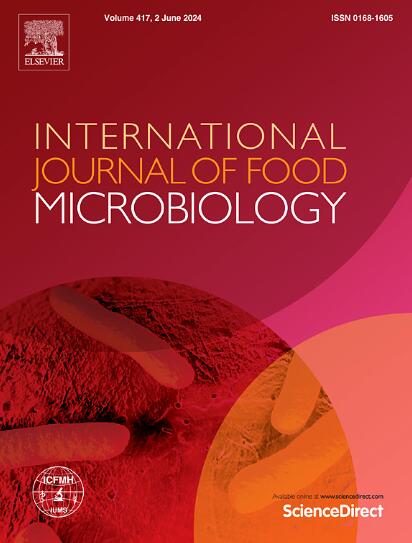Characterization and application of novel bacteriophage PS2 for controlling pathogenic Escherichia coli in different food matrices
IF 5.2
1区 农林科学
Q1 FOOD SCIENCE & TECHNOLOGY
International journal of food microbiology
Pub Date : 2025-06-26
DOI:10.1016/j.ijfoodmicro.2025.111330
引用次数: 0
Abstract
This study was aimed to investigate a novel Escherichia phage, vB_EcoS_PS2, which was isolated from sewage and identified as a member of the Dhillonvirus genus within the Caudoviricetes class based on its isometric head and long, non-contractile tail morphology. Whole-genome analysis confirmed the absence of genes associated with antibiotic resistance, lysogeny, and virulence factors in its 44,264 bp genome. Phage PS2 exhibited high specificity against E. coli strains at various serotypes, including O157:H7, O6, and O78:K80:H12. The biological property showed that phage PS2 had a short latent period (20 min) and large burst size (410 PFU/cell), and maintained stability when exposed to a broad range of temperatures (4–60 °C) and pH levels (4–10). In broth, phage PS2 effectively inhibited bacterial growth and delayed regrowth for up to 20 h. Additionally, phage PS2 effectively eradicated preformed biofilms, achieving a 4.8 log reduction in viable cell counts. Phage PS2 was evaluated for its biocontrol efficacy in milk, rice gruel, and packaged pork sausage at 4 °C and 25 °C. At higher MOIs, it significantly reduced bacterial populations, achieving up to 6.20 log reduction in milk, 5.94 log in rice gruel, and 5.26 log in sausage, showing its effective biocontrol potential. Compared to the control, phage PS2 treatment significantly reduced pathogenic E. coli populations with sustained inhibition across all tested food models. The solid food model showed varying efficacy depending on the MOI, highlighting the need for optimized application strategies in complex food matrices. To conclude, Escherichia phage PS2 exhibited excellent stability, strong lytic activity, and broad efficacy against various E. coli serotypes, establishing it as a promising biocontrol agent for enhancing food safety.
新型噬菌体PS2的鉴定及其在不同食物基质中控制致病性大肠杆菌的应用
本研究旨在研究一种从污水中分离得到的新型埃希氏菌噬菌体vB_EcoS_PS2,该噬菌体根据其等长头部和长而不收缩的尾部形态,被鉴定为尾状菌纲的Dhillonvirus属成员。全基因组分析证实其44,264 bp基因组中缺乏与抗生素耐药性、溶原性和毒力因子相关的基因。噬菌体PS2对O157:H7、O6和O78:K80:H12等多种血清型大肠杆菌均表现出高特异性。生物学特性表明,噬菌体PS2潜伏期短(20 min),爆发量大(410 PFU/细胞),在4 ~ 60℃和4 ~ 10 pH范围内均能保持稳定。在肉汤中,噬菌体PS2有效地抑制细菌生长并延迟再生长达20小时。此外,噬菌体PS2有效地根除预形成的生物膜,使活细胞计数减少4.8倍。研究了噬菌体PS2在4℃和25℃条件下对牛奶、米粥和包装猪肉香肠的生物防治效果。在较高的MOIs条件下,乳汁、米粥和香肠的细菌数量分别减少6.20 log、5.94 log和5.26 log,显示出其有效的生物防治潜力。与对照组相比,噬菌体PS2处理显著减少了致病性大肠杆菌种群,并在所有测试的食物模型中持续抑制。固体食物模型显示出不同的MOI效果,突出了在复杂食物基质中优化应用策略的必要性。综上所述,Escherichia噬菌体PS2对多种大肠杆菌血清型具有良好的稳定性、较强的裂解活性和广泛的药效,是一种很有前景的食品安全生物防治剂。
本文章由计算机程序翻译,如有差异,请以英文原文为准。
求助全文
约1分钟内获得全文
求助全文
来源期刊
CiteScore
10.40
自引率
5.60%
发文量
322
审稿时长
65 days
期刊介绍:
The International Journal of Food Microbiology publishes papers dealing with all aspects of food microbiology. Articles must present information that is novel, has high impact and interest, and is of high scientific quality. They should provide scientific or technological advancement in the specific field of interest of the journal and enhance its strong international reputation. Preliminary or confirmatory results as well as contributions not strictly related to food microbiology will not be considered for publication.

 求助内容:
求助内容: 应助结果提醒方式:
应助结果提醒方式:


